

![[DIGITALE BIBLIOTHEK DER FES]](/images/digbib/d_digbib.gif)

SECTION of DOCUMENT:
[page-number of print-ed.: 52]
Abel M. Mateus *
Portugal's Accession and Convergence Towards the European Union
* [Universidade Nova de Lisboa]
After a request to join the EEC in March 1977, Portugal joined the European Community on January 1st, 1986, at the same time as Spain. We are going to study first the pre-conditions for accession, and second the impact of Portugal’s entry on its economy over the decade and half that has elapsed since then. We will study both in terms of three criteria: macroeconomic stability, growth and convergence and political democracy.
The pre-accession period *
*[Most of the data presented throughout this paper are taken from Mateus 2001.]
After the 1974 Revolution, followed by an extensive nationalisation process and the transition to an incipient democracy after 40 years of dictatorship, Portugal was oscillating between a Latin American and European political and economic regime. After an agreement was reached in 1978 that Portugal would be accepted within the EC, negotiations took from October 1978 to March 1985along side those negotiations between the Commission and Spain. In retrospect, there is no doubt that political factors played a major role in the admission of the country to the EC, mainly the need to consolidate democracy and to avoid Portugal slipping into the socialist bloc.
The period of 1978 to 1984 was characterised by large macroeconomic disequilibria. Portugal had to go through two IMF supported stabilisation programs and benefited from EC pre-accession funds and a large loan "to support democracy".
However, on the eve of accession, disequilibria were substantially larger than for most of the current candidates. The inflation rate was particularly high and the government deficit was also high by developed country standards. The unemployment rate was reaching record levels after the crisis of 1982-83. Figure 1 illustrates the large disequilibria that prevailed in 1983. After the positive shock of the reduction in oil prices, the situation started to be redressed in 1985.
[page-number of print-ed.: 53]
Figure 1
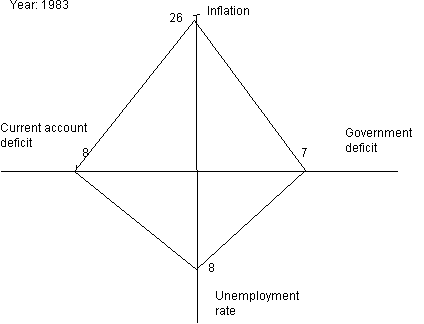
Growth was also disappointing during the pre-accession period. Figure 2 shows that from 1974 to 1986 Portugal lost about 6 percentage points in the convergence rate to the EU. In 1986 the GDP per capita in PPP was only 55% of the EU average, the smallest of all "cohesion countries". Greece and Spain were also experiencing a process of non-convergence.
A large part of the economy was in the hands of the state, and large parts of manufacturing and services were closed to the private sector. The press and radio stations were almost all state owned, the television was state property too. The labour market was heavily regulated with no possibility of laying people off. Wages were set by negotiations between the state and unions. There were two major political parties, the social democrats and the socialists, which alternated in power. In 1985, Cavaco Silva, a social-democrat premier, won the first electoral majority after democratic rule was established. Democracy was clearly at an incipient stage, with major constitutional revisions still taking place with some frequency.
[page-number of print-ed.: 54]
Figure 2
[Spain, Ireland, Portugal, Greece.]
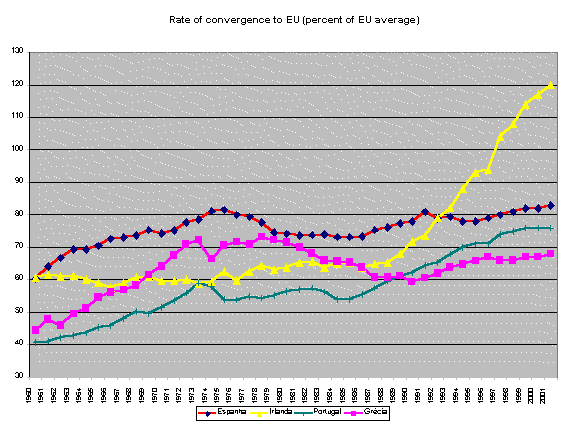
[load alternative image file in a new window]
Adjustment and growth
It was only after accession that Portugal had a cycle of high growth accompanied by structural reforms. From 1987 to 1991, GDP growth averaged 6.5%, about 3.5 percentage points above EU average, as Figure 3 (see page 53) documents.
A major factor behind the remarkable growth rate was a terms-of-trade improvement of 24% in 1984-85, and a real devaluation of 26% in the decade prior to 1985.
Another factor was the major structural reforms undertaken, which included: (i) fiscal reform – introduction of VAT and substitution of schedular taxes by a single income tax; (ii) privatisation – launched in 1989- started by the financial sector and major manufacturing enterprises; (iii) labour market reforms – short-term labour contracts were introduced and became the dominant type of labour contracts for new entrants into the market; (iv) financial sector modernisation – indirect monetary controls were introduced, interest rates liberalised and a modern regulatory framework introduced; and (v) infrastructure build-up – the country rapidly closed the large gap in infrastructure vis-à-vis the EU average.
Figure 3
[Portugal, European Union.]
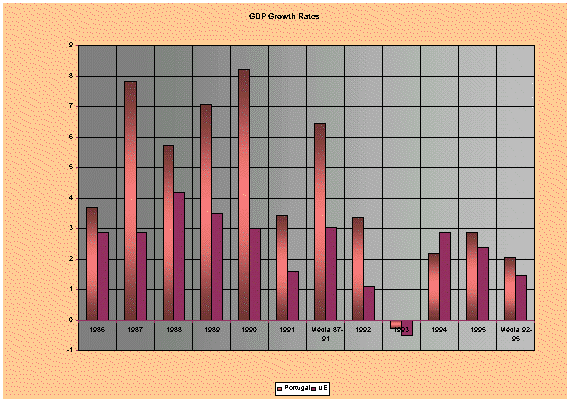
There was also an explosion first in rates of secondary education and in the early 1990s in higher education, although the base rates were among the lowest in the EU. However, reforms lagged in other fields, such as in education, health and the legal system, and there was a large increase in wages in the early 1990s that led to a substantial increase in current public expenditures.
The large impact of trade in the economy is reflected in a jump in the ratio of average exports and imports over GDP from 29% in 1985 to 53% in 1995. Direct foreign investment also increased substantially in the early 1990s. Confirming gravity models, the largest increase in trade was between Portugal and neighbouring Spain.
The country may have entered the EC with an undervalued exchange rate. As a consequence, most of the studies on patterns of trade and production show that the impact of the accession was an increase in intra-sectoral trade that was biased towards exports of low-quality goods produced in low-wage labour intensive sectors.
[page-number of print-ed.: 56]
Figure 4
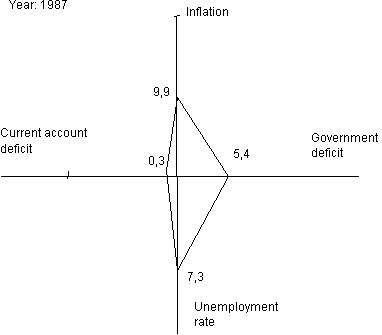
Stabilisation proceeded at a slow pace (Figures 4 and 5). Inflation was lowered substantially; but it was only after 1993 that major progress was achieved (Figure 6). The current account was balanced from 1985 through 1995; the unemployment rate was lowered to about 4.5% in 1992 but increased afterwards until the beginning of 1997, and then fell to about 4% in 2000.
Figure 5
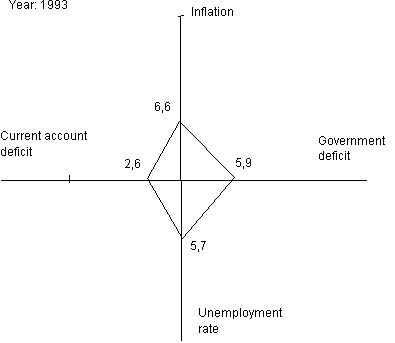
Figure 6
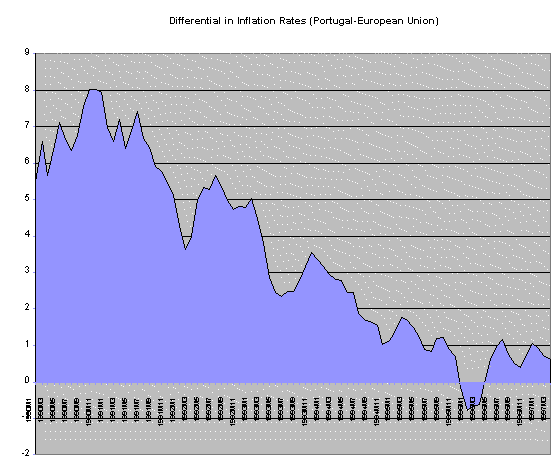
[load alternative image file in a new window]
The stabilisation process was only consolidated after Portugal signed the Maastricht Treaty and all major political parties were committed to putting Portugal in the first wave of the Euro candidates. The nominal convergence process was centred on maintaining the Escudo in the Exchange Rate Mechanism of the European Monetary System, lowering the inflation rate and reducing the government deficit.
The political system showed important changes towards improving democratic institutions, as communication infrastructures were privatised and a major political shift from social democrats to socialists took place in legislative elections in 1995. With the speed of privatisation accelerating in 1992-1994, a large share of the economy was taken over by the private sector and public enterprise deficits were substantially lowered.
Deceleration and structural problems
Despite the success achieved during the 1985-1995 period, an important deceleration in the convergence process took hold after the 1992 recession and the new business cycle. Extrapolation of the 1986-1994 growth rates would put Portugal over the EU average in 13 years, starting in 2001. However, using the 1995-2003 [For 2002-2003, estimates based upon the projections of European Commission.] GDP growth average, it will
[page-number of print-ed.: 58]
take Portugal 47 years to reach the EU average. Figure 7 illustrates the deceleration in the convergence rate.
Figure 7
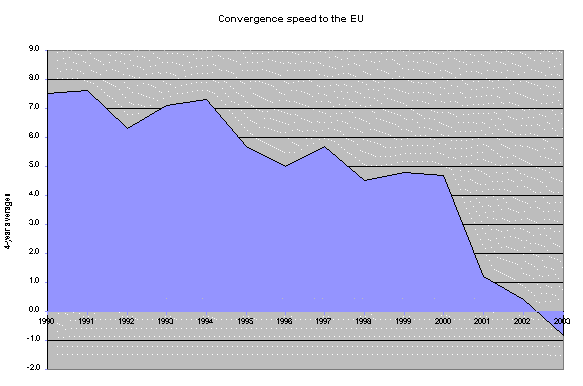
Divergence is not an entirely new or surprising phenomenon. Greece had more than a decade of divergence, and Portugal itself experienced the same process in the late 1970s up to the mid-1980s. The main reasons for this deceleration in the convergence process are:
- the increasing tax burden and large waste in public expenditure. As Figure 8 shows, in the last decade the share of the public sector over GDP increased by about 12 percentage points and reached more than 50%.
[This trend is at odds with the rest of the EU countries that lowered the weight of the public sector during the 1990s. The situation has evolved rapidly and old indicators can be misleading. In its report on the social situation of its member states in the year 2000, published in 2001 (European Commission 2001), the EU uses figures for 1994 to show that Portugal has one of the lowest ratios of social expenditures over GDP among EU countries. This is no longer the case. Nowadays, Portugal has a share slightly above the EU average, but with 25% less in income per capita.]
Studies conducted by international organisations have shown widespread waste in government expenditures (the country spends double in education and health to reach similar levels of EU social indicators), and overall tax burdens are among the highest in the EU; - the lowering share of "productive investment", over-investment in physical infrastructures and housing, and the implementation of large public investment projects of doubtful economic and social rate of return;
[page-number of print-ed.: 59]
- losing real competitiveness – measured in real unit labour costs, Portugal has lost about 50% vis-à-vis Ireland since 1987-, and lowering of FDI (in the last two years the balance has turned heavily negative).
- lagging investment in technology intensive sectors; [A recent study shows that Portugal is behind several Eastern European countries in the effort to acquire technologies in the "new economy".]
Figure 8
[Denmark, Portugal, Ireland, Finland, United States, European Union.]
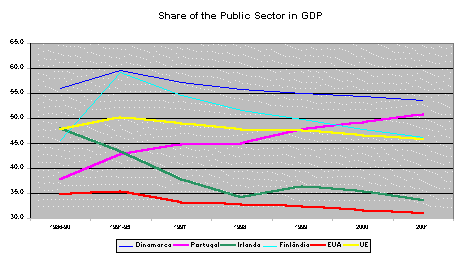
At the same time, major structural weaknesses started to appear and its impact started to be reflected in the potential GDP. Among those were the recurring problems in education, health, justice and social security. Portugal remains the EU country with the lowest rates in schooling of youths, and the quality of education revealed by testing in mathematics and science is also among the lowest in OECD countries.
However, since 1995, an expansion in public expenditure through extra-budgetary means and the expansion of credit to the economy have stimulated aggregate demand. With the lowering of interest rates, and the participation in the Euro that meant lack of an exchange rate discipline, households substantially increased their expenditure and the banks, spurred by intensified competition, started to push credit to housing and consumption in high volumes. Credit has expanded at a yearly rate of between 20% and 30% since the beginning of 1999 (Figure 9), as loan real interest rates became negligible in real terms. As a consequence, the rate of household indebtedness increased from about 20% in 1993 to 100% of disposable income in 2001, and is still increasing at about 8 percentage points a year. Enterprise indebtedness increased at similar rates, as the government shifted more and more expenditures to off-budget institutions that financed themselves through bank credit.
[page-number of print-ed.: 60]
Figure 9
[Households and enterprises; real interest rates.]
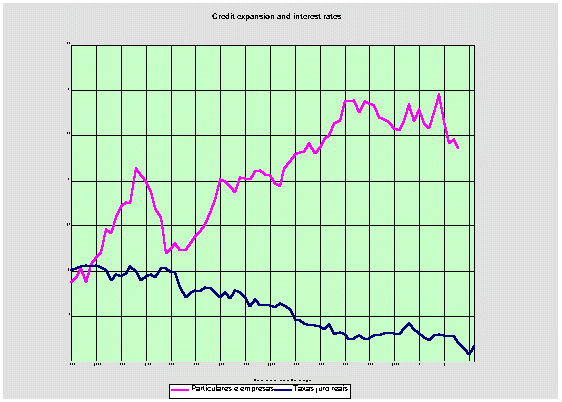
[load alternative image file in a new window]
In view of the large drop in savings rates, the expansion in expenditure had to be financed by foreign capital inflows – the banks sold the public debt on their balance sheets to foreigners (50% of GDP) and increased their borrowing with foreign banks. As Figure 10 shows, the net wealth position of Portugal vis-à-vis foreign countries has deteriorated substantially, from a position of about –12% of GDP in 1995 to –50% in 2001 and it is expected that it will reach –80% in 2004 before starting to level off. [We used the current European Commission current account deficit projections up to 2003 and extra polated them for the remaining years.]
This inflow of foreign resources has been mainly directed to finance the consumption boom and investment in non-tradables – housing, EXPO98 and large infrastructure projects. This poses a major problem given the sustainability of the current account deficit.
There are symptoms that this period was marked by an overvaluation of the exchange rate as indicators of the real exchange rate show, and that the country may have locked-in to the Euro at an overvalued rate – contrary to the case of Ireland. The symptoms are the boom in consumption and the rapid deterioration in the current account, although a large part was due to the expansionary budgetary and credit policies.
There have been some questions raised about governance. The change in government that occurred in 1995 led to the replacement of more than seven thousand high and middle officials in the Public Administration along party lines. Not one case of corrup-
[page-number of print-ed.: 61]
tion brought to court or to the attorney general has led to punishment of the suspects yet. The government has been accused of favouring the largest economic groups in privatisation and in distributing subsidies. The state continues to have a dominant position in strategic sectors: from banking to telecommunications, paper pulp to cement. In most of the cases, they retain a "golden share" and there were cases (the most publiccised was banking) where it blocked cross-border mergers from other EU countries. [Some of these aspects are not unique to Portugal and other European countries also use some of these practices, but they are harmful to a democratic EU, as they violate the EU treaties.]
Figure 10

The challenge of enlarging Euroland
Lacking a complete simulation of EU accession on current members, we use more recent estimates of the impact of the Single Market and Structural Funds – both initiatives dominate the 1998-2000 period – on cohesion countries. Both initiatives show favourable results, as the following table, based on a general equilibrium model, documents. The Table shows the impact on each variable vis-à-vis a baseline scenario. Trade liberalisation in Portugal took place mainly in the pre-accession period, except for trade with Spain. Portugal has received the equivalent of 3% to 4% of GDP annually, from structural funds and other Community initiatives, from 1989 to 2001. Under the current Plan, the level of funds falls to slightly less than 3% in 2006 (Agenda 2000).
[page-number of print-ed.: 62]
Portugal shows the largest impact after 15 years, both in terms of trade liberalisation and impact of the funds. Other estimates of the impact of the funds show a contribution of about half a percentage point each year. The FDI flows and their impact have been of similar magnitude, if we compare both flows on a net basis.
Table 1: Impact of Single Market and Structural Funds on cohesion countries
Trade liberalisation effects |
Effects of structural funds* |
Combined effect ** |
||||
GDP |
Unemployment |
GDP |
Unemployment |
GDP |
Unemployment |
|
Portugal |
||||||
1995 |
3.9 |
-1.9 |
10.6 |
-6.4 |
10.4 |
-7.9 |
2000 |
11.5 |
-7.7 |
11.6 |
-5.5 |
14.7 |
-11.5 |
Spain |
||||||
1995 |
4.8 |
-1.2 |
2.2 |
-0.4 |
0.9 |
-0.6 |
2000 |
9.2 |
-2.0 |
2.1 |
0.1 |
1.4 |
0.4 |
Greece |
||||||
1995 |
-1.3 |
2.0 |
6.9 |
-3.8 |
4.7 |
-2.7 |
2000 |
0.1 |
1.6 |
7.4 |
-2.1 |
5.9 |
-2.9 |
Ireland |
||||||
1995 |
5.0 |
-1.4 |
2.7 |
-0.4 |
6.6 |
-2.0 |
2000 |
9.2 |
-1.2 |
3.4 |
0.3 |
10.5 |
-1.0 |
Source: European Commission (1997)
- * [With externalities.]
** [Without externalities and FDI inflows.]
Impact of the enlargement on structural funds and CAP
The negotiations for Agenda 2000 already showed how difficult it is to lower benefits to cohesion countries, and the Spanish and Portuguese governments have announced their opposition to a cut in the structural funds in the next Community Budget Framework (2007-2013), as a consequence of the enlargement. This may be a first step in the negotiation process, however, we think it will not be tenable over the long term.
We think that the basic principle for negotiations should be that all current EU members must share the burden of enlargement on an equitable basis. Although the principle may carry a large appeal, the problem is in the details. Under this principle, net contributors should increase their contribution and net receivers should have their benefit cut. But Germany has already announced that it will not increase their contribution and even wants it cut. The cost of enlargement may be about 20% to 30% of the total Community Budget in the forthcoming years (about 20 to 30 billion Euros), so it will impose a substantial burden on present EU members. [There is already an agreed adjustment: Ireland will not receive any further cohesion funds.]
But when the question is raised on a global basis, we also need to take into account the present common agricultural policy (CAP), and its future reform. It is quite clear that the
[page-number of print-ed.: 63]
present CAP causes a large cost in terms of inefficiency to consumers and producers of the EU. It will also imply a large increase in budgetary costs if extended under its present form to the candidate countries that have large agricultural sectors. Therefore, a major reform will have to be agreed at negotiations to be concluded by 2005, which will imply a drastic reduction in payments to the current EU farmers. This reform will also have a positive impact in increasing the net contribution of France and Denmark to the EU budget, which is desirable on equity terms (if we take GDP per capita, for example).
We would also advise that studies should be conducted during negotiations by the Commission and Candidate Countries on the net welfare impact of phasing in the CAP, in view of the large welfare loss that it may cost the consumers due to price increases. To date, Portugal has lost a substantial amount of consumer welfare due to CAP. [For a more detailed analysis see Mateus 2001.]
Need to strengthen macroeconomic stability
The Maastricht criteria are not enough to assure financial stability. Candidate Countries have been trying to abide to fiscal discipline through annual frameworks, but there are two important aspects that have to be recognised. First, governments have used all sorts of tricks to circumvent government deficits and debt figures. There is an urgent need to revise accounting procedures and to strengthen surveillance and audit in this regard.
Second, most of the recent crisis models have brought to the fore the crucial role of financial fragility on the occurrence of crisis. This fragility may occur because of balance sheet effects of major asset price fluctuations (housing, stocks, and foreign currency). This means that financial sector supervision and particularly banking supervision is too important to just be placed at national level. Community institutions should play an important role.
Need for strengthening institutional change
In cohesion countries, the EU is usually highly popular because, in our view, of two major contributions: (a) to strengthen democracy and further institutional modernisation, and (b) as contributing to infrastructure projects. The EU has, above all, to continue its mission in Candidate Countries along the same lines. This is a major challenge. First, because democracy in most of the Candidate Countries is relatively young. Second, because infrastructure projects have to be efficient and not seen as a waste of resources.
Although economic reforms are important, the lack of or slow process in institutional reforms can be a major drawback to the convergence process (in areas like justice, education or the political decision process).
[page-number of print-ed.: 64]
Conclusion
Summarising, we will consider the main recommendations for the enlargement process, and the future of a cohesive EU:
- Structural funds are not enough: what is necessary is an efficient program of public sector current and capital expenditure. Money is fungible, so the Commission may refuse to finance a "white elephant", but the country will divert resources freed from Community contributions to other projects, to pursue those projects, which may be harmful to the efficiency and growth of the economy. Countries receiving large structural funds should be encouraged to prepare an overall investment strategy for the public sector that should be discussed with the Commission. Programs submitted for financing should be drawn according to that strategy and attribute high priority to efficiency, equity and a substantial portion targeted to the poorest. Thus, the European Commission should exert a more thorough analysis of expenditure programs and screening investment projects.
- Macroeconomic stability should go hand in hand with structural reforms. Countries that are not far ahead in structural reform, especially in building a well functioning market system, should not enter.
- Countries should try to avoid major swings in real exchange rates although this may be difficult as the experience of Candidate Countries show. They might lead to the wrong specialisation in trade and production and delay required adjustments in resource allocation, or cause major disequilibria in the balance of payments.
- Deficits in the current account may occur due to intertemporal smoothing of consumption or temporary shocks, but when they persist and become unsustainable, it is usually a sign of macroeconomic disequilibria and should be corrected to avoid, in the long run, currency or financial crisis.
- It is now widely recognised that a high level of transfers may create Dutch disease problems. So we welcome the 4% of GDP limit to those transfers. However, this limit discriminates against small poor countries, and should be complemented by a per capita limit. The other negative impact of subsidies is the rent-seeking activities that it creates in the receiving countries. The Community needs to strengthen its auditing and procurement mechanisms, and to establish systems that are as competitive as possible in order to avoid corruption and favouritism by national governments. This is of the utmost importance if we want to avoid the effects of the "grabbing hand" [This term refers to the book published by Andrei Shleifer and Robert W. Vishny.] and promote a just and equitable system in a democratic Europe.
[page-number of print-ed.: 65]
References
European Commission (1997), The Single Market Review, vol. 2, Brussels
European Commission (2001), The Social Situation in the EU 2000, Brussels
Mateus, Abel (1999), Portugal’s Accession to the European Union, The Second Decade: Prospects for European Integration after Ten Years of Transition, chapter 8, Sdu Publishers, The Hague
Mateus, Abel (2001), Portuguese Economy, Second Edition, Verbo, Lisbon
Shleifer, Andrei and Vishny, Robert W. (1999), The Grabbing Hand: Government Pathologies and their Cures, Harvard University Press.
© Friedrich Ebert Stiftung | technical support | net edition fes-library | März 2002